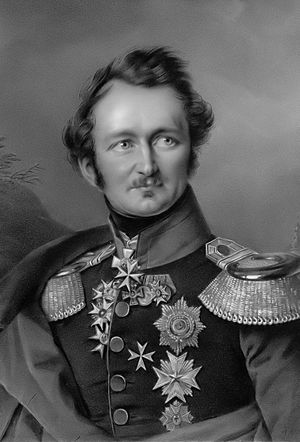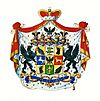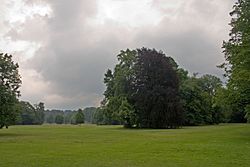Hermann, Fürst von Pückler-Muskau facts for kids
Quick facts for kids
Hermann von Pückler-Muskau
|
|
|---|---|
 |
|
| Coat of arms |  |
| Full name |
Hermann Ludwig Heinrich von Pückler-Muskau
|
| Titles and styles | Count (1785) Fürst (1822) |
| Born | 30 October 1785 Muskau Castle, Electorate of Saxony |
| Died | 4 February 1871 (aged 85) Branitz, Kingdom of Prussia |
| Buried | Schloss Branitz |
| Noble family | Pückler |
| Dowager Countess | Lucie von Pappenheim, née von Hardenberg |
| Father | Carl Ludwig Hans Erdmann Pückler |
| Mother | Clementine of Callenberg |
| Occupation | Landscape gardener; author; soldier |
Prince Hermann Ludwig Heinrich von Pückler-Muskau (born as Count Pückler, from 1822 Prince; 30 October 1785 – 4 February 1871) was a German nobleman. He was famous for his amazing skills in designing gardens and parks. He also wrote many books, mostly about his travels in Europe and North Africa. He published these books using the pen name "Semilasso".
Life of Hermann von Pückler-Muskau
Hermann von Pückler-Muskau was the first of five children. His parents were Count Carl Ludwig Hans Erdmann Pückler and Countess Clementine of Callenberg. He was born at Muskau Castle in Upper Lusatia, which was then part of the Electorate of Saxony.
He served as a soldier for a while in a cavalry group in Dresden. After that, he traveled through France and Italy, often walking. In 1811, his father passed away, and Hermann inherited the family estate of Muskau. He joined the war against Napoleon I of France and showed great bravery as an officer. Later, he became a military and civil governor in Bruges.
After the war, he left the army and spent a year traveling around Great Britain. He easily made friends with important people there. He went to plays, studied how parks were designed, and visited famous places. In 1822, King Frederick William III of Prussia made him a "Fürst" (Prince). In 1817, he married Lucie von Pappenheim. Their marriage ended legally after nine years in 1826, but they remained good friends.
He returned to England in 1828. He became quite well-known in London society. He spent almost two years looking for a wealthy second wife who could help pay for his big garden projects. His travels also took him to Ireland. When he returned home, he wrote a book about his time in England. This book was a huge success in Germany and also became popular in English as Tour of a German Prince (1831–32).
Being a very adventurous person, he later traveled to Algeria, Tunisia, Egypt, and Sudan. He explored ancient Nubia. In 1837, he visited the ancient sites of Naqa and Musawwarat es-Sufra in modern-day Sudan. He even carved his name into the stone of the temples there. In the same year, he met a young Oromo girl named Mahbuba ("the beloved") in Cairo. She became his companion and traveled with him to Asia Minor, Greece, and Vienna. He introduced her to important people in Europe. Sadly, Mahbuba became ill and passed away in Muskau in 1840. He later wrote that she was "the being I loved most of all the world."
Hermann then lived in Berlin and Muskau. He spent a lot of time improving the beautiful Muskau Park, which still exists today. In 1845, he sold this estate. Although he lived in different places in Germany and Italy, his main home became Schloss Branitz near Cottbus. There, he created another amazing park.
He was a liberal in politics, supporting reforms in Prussia. His unique beliefs and colorful life made him stand out in society.
In 1863, he became a member of the Prussian House of Lords. In 1866, even though he was 80 years old, he joined the Prussian general staff during the Austro-Prussian War. He received an award for his actions at the Battle of Königgratz, even though he had slept through the day!
He passed away in Branitz in 1871. He had special instructions for his burial. His body was prepared in a unique way, and then buried in a special earth pyramid called the Tumulus. This pyramid is surrounded by a lake in the park at Branitzer Castle.
Since he had no children, his castle and estate went to his nephew, Heinrich von Pueckler. His niece, Marie von Pachelbl-Gehag, received money and other belongings. His writings and diaries were inherited by the writer Ludmilla Assing, who wrote his life story and published his letters and diaries after his death.
Hermann von Pückler-Muskau as an Artist
As a landscape gardener, Hermann von Pückler-Muskau was very important in Europe. He designed stunning parks that are still admired today.
He was also a talented travel writer. He had a sharp eye for details, and his writing was clear, lively, and funny. His first work, Briefe eines Verstorbenen (4 volumes, 1830–1831), shared his thoughts about England and other countries he visited. He also wrote Andeutungen über Landschaftsgärtnerei (1834, "Remarks on Landscape Gardening"), which was very influential.
In 2016, the Bundeskunsthalle in Bonn held an exhibition about him called "The Garden Landscapes of Prince Pückler." Two of his gardens are now on the UNESCO Lists of World Heritage Sites. These are the Bad Muskau garden and the Babelsberg garden near Potsdam. Both are considered masterpieces of 19th-century garden design in Europe.
He also made drawings and caricatures, but he did not publish them.
Fürst-Pückler-Eis
His name is still used in German cooking for Fürst-Pückler-Eis (Prince Pückler ice cream). This is a type of Neapolitan ice cream that combines strawberry, vanilla, and chocolate ice cream. It was named in his honor by a royal cook in 1839.
In a book by Roberto Bolaño called 2666, this ice cream is mentioned as an example of how someone's fame can come from something small and unexpected.
Images for kids
See also
 In Spanish: Hermann von Pückler-Muskau para niños
In Spanish: Hermann von Pückler-Muskau para niños










